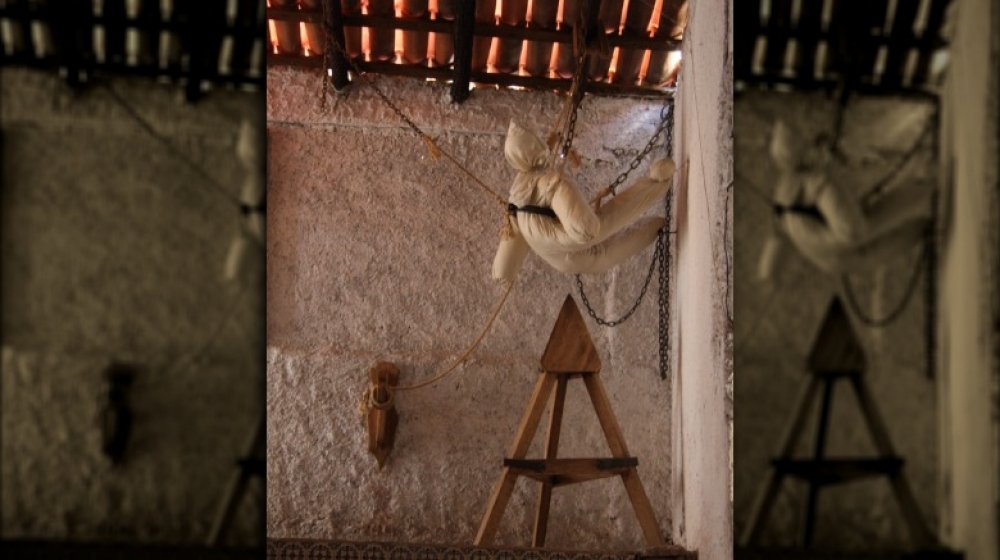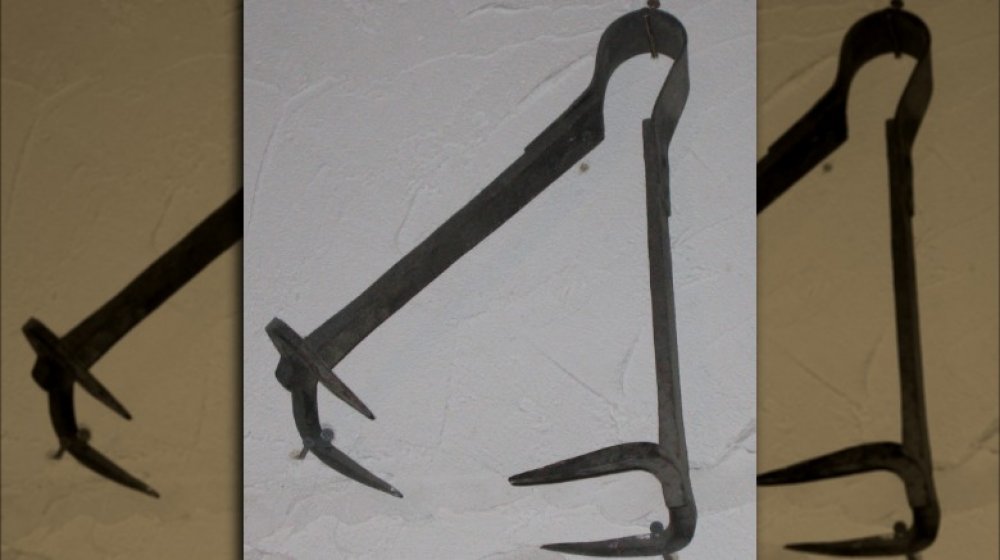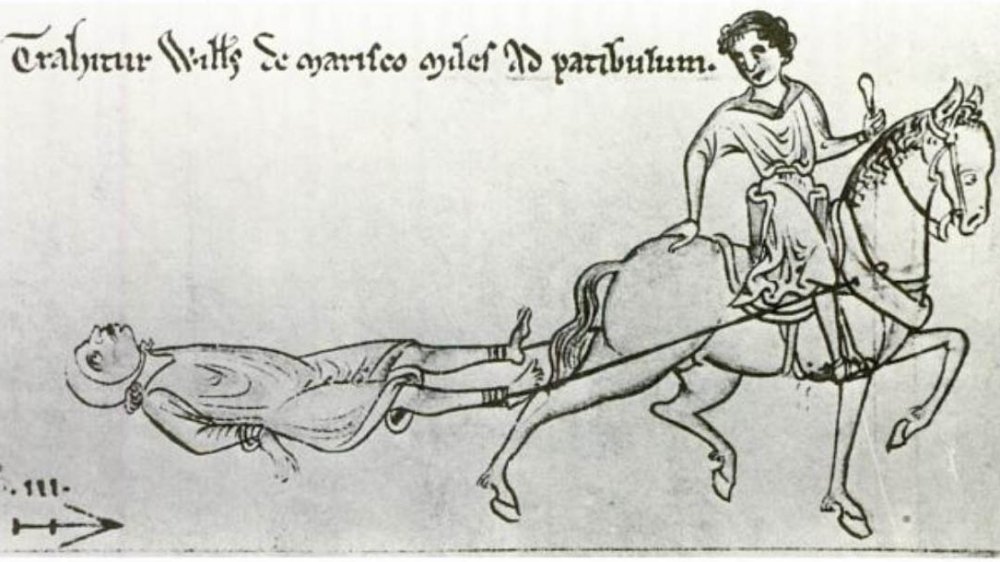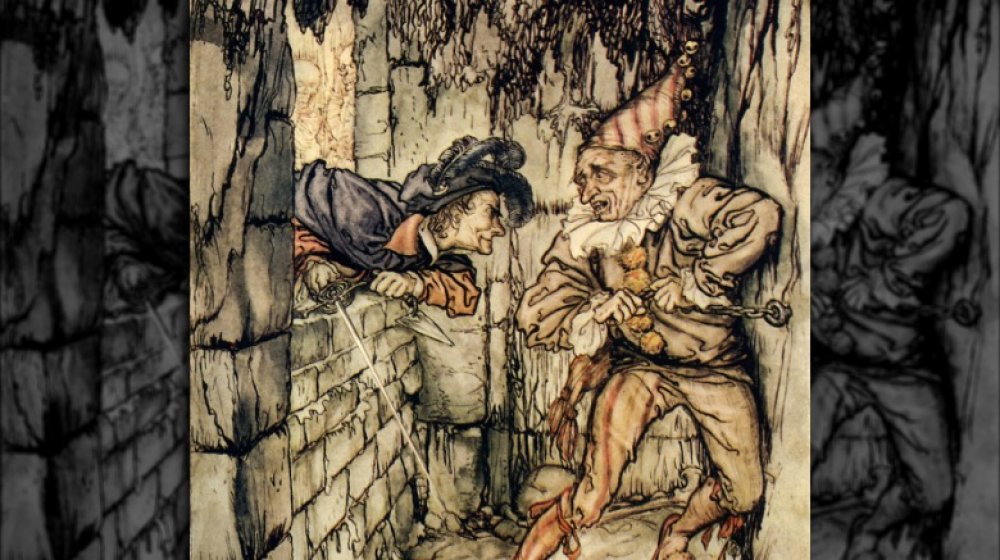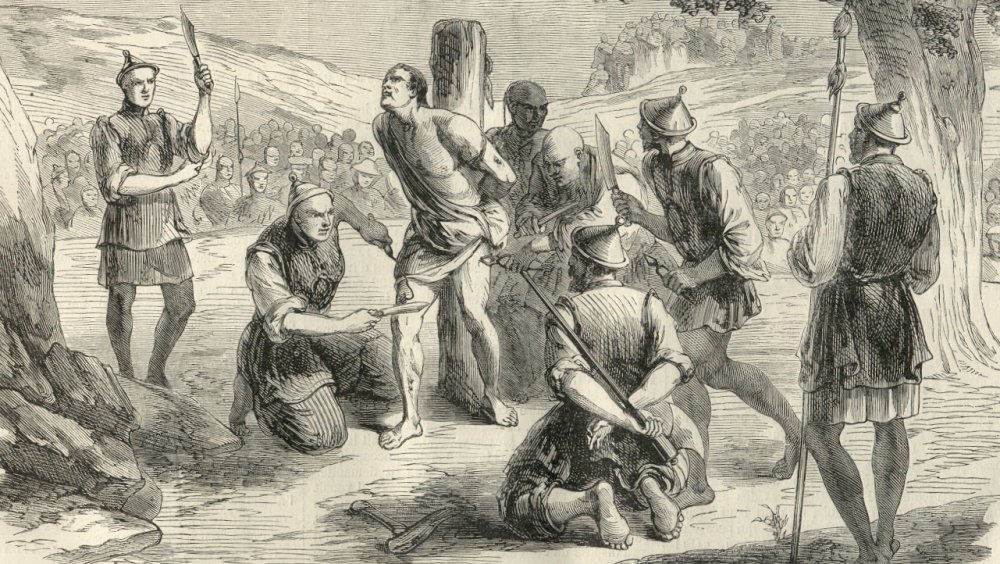History's Darkest Forms Of Execution And Torture
Humans do cruel things. It's one of the qualities that separates us from other animals. Sure, death and pain occur in the animal kingdom, but there's a functional cause for it. The animal is scared and fighting for self-preservation, or the animal is killing so it can eat. These are acceptable things in nature. Humanity's need to wage war, kill each other over ideas or beliefs, and to inflict unnecessary pain is a unique darkness. What's worse is that sometimes, humans commit these atrocities for unfathomable concepts like greed or the sheer, sick pleasure of tormenting another person, something that's entirely sociopathic.
Thanks to the dark side of humanity's nature, we've spent millennia perfecting the best ways to torment, kill, and mutilate. Most of the torture and execution methods on this list are so dark that they've been outlawed for ages. They stand now as a reminder of a cruelty humankind should be ashamed of ever embodying as well as a warning of what we're capable of at our darkest. So, if you find yourself wishing any of these tortures or executions on your worst enemy, you should probably find a therapist right away. You have a few things you need to work through.
A maritime death worse than walking the plank
A childhood fascination with pirates has no doubt left you knowing of the classic execution "walking the plank." The victim's hands are bound, and they're forced to walk off a board and into the deep blue sea. The torment of staring into the abyss below them, knowing that they're destined for Davy Jones' Locker, is what makes walking the plank terrifying, but it's not as bad as keelhauling.
Keelhauling was a punishment used by the Dutch navy and rumored to have been employed by the British Royal Navy and pirates alike during the 17th and 18th centuries, according to ATI. There are several written accounts of keelhauling occurring, but many of those were in fictitious novels. An Universal Dictionary of the Marine, published in 1780, confirms that the Dutch at least used this method. Keelhauling itself involved tying a prisoner to a long rope connected to the mast and dragging them under the water from one side of the ship to the other. The victim would scrape across the keel of the boat, hence "keelhauling," and would emerge on the other side. Weights could be tied to the victim to ensure that they'd stay under the ship as well.
The hulls of ships back then weren't cleaned very often, so the victim would be scraping against sharp barnacles while nearly, or completely, drowning. Keelhauling was an extreme form of punishment used to send a message to other mariners who might think about stepping out of line.
Cooked alive inside the Brazen Bull
The brazen bull may or may not have existed. It's an old enough execution method, dating back to ancient Greece, that it's difficult to find evidence one way or the other. The brazen bull is mentioned in some ancient Greek writings, such as in the writings of Cicero, but there isn't enough proof to say for certain that this method was ever used. Regardless, the mind that conceived the concept must have been a dark one.
The brazen bull, as legend states, was a hollow bronze statue of a bull fitted with certain demented fixtures. The nostrils were holes where steam and smoke could escape when the fire beneath made the bull sufficiently hot. You know, with a human body inside of it. The nose of the bull is said to have been packed with incense to prevent an observing crowd from sickening by the stench of burning flesh, according to History Daily. The bull is also said to have been fitted with special tubes that turned the victim's screams into the snorts of the brazen bull, a form of sadistic entertainment to make the execution more exciting.
Lit up like a Roman Candle
Being burned alive doesn't sound like a whole lot of fun unless, of course, that's the sort of thing you're into, and you probably shouldn't be. For as awful an execution as burning alive is, it has been a staple in societies from around the world for millennia, and some methods of burning a victim alive are clearly more awful than others.
The "Roman Candle" was nicknamed as such because of its place of origin and has nothing to do with fireworks. This execution method is believed to have started with the Roman emperor Nero, who we all know did some seriously wicked things. It's said that Nero used this punishment to persecute Christians after Rome burned under his rule. Now, there's no saying that Nero for sure used this method, nor who he may have executed with it if he did, but there are enough horror stories about it passed down through the ages to make it worth looking at.
The story says that Nero, punishing people for burning down Rome, would burn the condemned to death in viewing parties for Rome's elite. It was a private affair meant to entertain sick minds, according to Infographics. The method involved tying a victim to a stake, covering them pitch, oil, or wax, and burning them slowly from the feet up to serve as torches to light their party. Humiliation: check. Torture: check. Nero was one sick dude: check.
Impalement and the Judas Cradle
Impalement has been a popular torture method throughout history because it's effective. It always ends in death. However, many people wrongly assume that a giant spike going through a body would kill a person quickly. That's not always the case. Take Vlad the Impaler's method, for example. He drove spikes through one of his victim's lower orifices in a way where it would protrude from the neck or upper torso, sometimes the mouth, without hitting vital organs, according to NBC. This method, especially if the pole was rounded, could keep the victim alive for as long as the pole passed through their entire body or longer.
The Judas Cradle was a specific instrument of impalement. It used a pointed pyramid of wood, which the victim was lowered onto, their perineum making contact first. With the help of weights or gears, gravity slowly forced the victim onto the pyramidal spike as it wedged through their body. The condemned persons would usually die from blood loss, according to the Torture Museum. If, for some reason, the victim survived the impalement, infection would take them shortly after. It's not like they cleaned those things.
Being munched on by rats
It's just like humans to get animals to the things we don't want to do ourselves. Don't want to lay eggs? Get a chicken to do it for you. Don't want to trek through the snow? That's what dogs are for. Not in the mood to chew through another human body? Enlist the rats for help. If critters make you nervous, then torture by rats isn't the torture for you.
Here's the thing about rats: They bite hard. Seriously hard. These adorable sewer dwellers can chew through pipes, floors, walls, you name it. Somewhere along the line, as early as the 17th century, humans figured this out and turned the rodents' capable teeth into instruments of torture. The rats would be put in a cage or pail and placed atop the victim's torso, with the only opening to the container resting on the victim's flesh. The container would then be heated with coal until the rats knew they were being cooked alive. They'd have to escape or die themselves, so they'd typically take the path of least resistance. In this case, that means chewing through the flesh of the victim.
If the above doesn't sufficiently give you nightmares, consider this: According to ATI, the method of rat torture evolved in Argentina in the 1900s to include rats being fed through a tube into a victim's rectum.
Stripping off living flesh
Despite what Game of Thrones would have you think, the medieval era wasn't filled with Ramsay Boltons running amok, torturing everyone who crossed their paths. Flaying, the stripping of one's flesh, wasn't exactly common practice. But, that doesn't mean it never happened.
Flaying could be as insignificant as removing small strips of skin from a person's body to torture them or as grand as completely skinning a person alive. Saint Bartholomew was said to have been flayed when he was martyred, but most stories with roots in the Bible aren't confirmable. According to the book Flaying in the Pre-Modern World: Practice and Representation (via Longwood University), there's only one confirmed account of flaying from the Middle Ages, and that was the flaying of a Venetian commander who was mutilated by Turks after the siege of Cyprus.
The commander's skin was found in his tomb in 1961, and he was determined to have gone through the full punishment that flaying has to offer. His skin was entirely removed from his body and stuffed with straw like some sort of grotesque teddy bear.
The breast ripper
This torture was as misogynistic as it sounds. Let's face it: Human history is full of men controlling and brutalizing women. Women were tortured for a lot of the same things as men — blasphemy, heresy, treason, and so on — but they were also tortured for offenses that ran afoul of men's desire to keep women under their control, such as having children before marriage or committing adultery. The breast ripper, according to the Dictionary of Torture, was one of the many devices used for such things.
The device does pretty much what you'd think it does. It rips the breasts, or at least part of them, from the body. It's a primitive device that looks like a large set of iron boob-tweezers with a couple of ghastly spikes used to grip into the tissue. The breast ripper was usually heated for a touch of blazing-hot pain or frozen to cause equal pain on the other end of the temperature spectrum. The torturer would clamp the device down on the breast, pull, rotate, and repeat until there wasn't anything left. Another notable device used for a similar thing was the spider. The spider looked similar but was used to claw at breast tissue rather than rip it.
Hanged, drawn, and quartered
The hanged, drawn, and quartered method of execution, as you probably guessed from the name, was complicated and contained several moving parts. This execution was a punishment for treason in England and, according to Britannica, its official use dates back to 1283. "Hanged, drawn, and quartered" is a bit of a misnomer, since "drawn" was usually the first part of the punishment. The traitor would be lashed to horses and dragged to the site of the next punishment: hanging.
Once the horse-dragged and battered traitor made it to the gallows, they would then be hanged. Logically, you might assume that the victim died at the gallows since most hangings are fatal, but not in this case. They'd hang the traitor in such a way that their neck wouldn't break, and they'd only be mostly dead. Often, the victim got some extra punishment between being hanged and being quartered. This could include being disemboweled while still alive and having their entrails burned in front of them. You can live for a short bit without intestines.
At the end came the quartering. If you were lucky enough, they'd start with a beheading so you didn't have to feel much of the quartering. If not, your last experience was having your body hacked to pieces. You might think it's all a little overboard, but that's only because it was.
The Blood Eagle gives you wings
Made famous most recently with Vikings and the lesser-known, but totally worth watching, Norsemen, the Blood Eagle was a gruesome and torturous execution perpetrated by the Saxons back when Vikings were still a thing. Like with many of the older, brutal executions, it's difficult to tell if the Blood Eagle was ever actually played out or if the concept was thought up in a fictional context. Either way, Smithsonian Magazine says it's mentioned in several old Icelandic sagas and was, at one point, believed to be a real form of execution. So, we're going to run with it as "conceptual" and let the experts figure out the rest.
The Blood Eagle was basically a checklist of terrible things a Viking should do to give the victim wings. First, the victim would be tied down while the image of an eagle was carved into their back. Then, the ribs would be cut from the spine with an ax and snapped up one by one, mimicking unusable flesh and bone wings. The victim is still alive at this point, in theory, while the Viking is hard at work rubbing salt into the open wounds, making the wings flutter from the victim's spasming pain. Only after all of that was the victim killed, usually by pulling the exposed lungs through the wounds.
A Poetic way to die
Immurement is the act of confining a person to a small space. Technically, locking someone in the car, putting a person in a cage, or burying someone alive all count as immurement, but from a torture and execution standpoint, it tends to follow a more specific definition — basically, walling someone up in a confined space. It's the same method of execution Edgar Allan Poe's fantastically twisted mind dreamed up for "The Cask of Amontillado."
As far as ways to be executed go, immurement doesn't carry the torment of physical pain. Instead, it draws on the good type of pain to torture its victims: psychological. The victim is confined to a small, dark space sans windows, with the only exit bricked up in front of them. It usually takes a couple of days for an immured person to die of starvation or dehydration. The punishment carries all the perks of being buried alive — complete darkness, solitude, the knowledge of your impending death — minus the quick release of suffocation. Plus, you get to starve to death while you're at it. The psychological torment would surely drive a person insane before they bite the proverbial dust.
Not everyone died from immurement, according to ATI. Sometimes it was used as an even worse version of solitary confinement, where you were released after a short while or fed but kept confined for the rest of your life.
Leaving 'em for the bugs
As far as torture goes, this method is as disgusting as it is gruesome. It's called "scaphism," and it's the darkest form of "potty humor" in history. Scaphism dates back to the Persian Empire in the fifth century BCE. Like most ancient forms of torture, it's difficult for historians to say how often it was used or if it existed outside of theory. Let's hope it didn't. This is an awful way to die.
When you see the word "scaphism," you always see the phrase "milk and honey" along with it, and there's a reason for that. First, the victim would be bound to two small wooden "boats," one underneath and one laid over, with their limbs and head exposed, usually in a swampy area, according to Cultura Colectiva. Why a swamp? Swamps have bugs. This is where the milk and honey come in. The victim was force-fed the stuff — so much so that it gave them terrible diarrhea. The boat below caught that fly-enticing diarrhea and attracted bugs to eat at the victim's exposed body parts.
It took a long time to die from scaphism, long enough that you'd think the dehydration would get the victim first, but no, the tormentors wouldn't let their victims off the hook that easy. They'd just keep showing up and force-feeding more milk and honey, which has enough moisture and nutrients to keep you alive for quite a while. Alive, in your own poop, while eaten by bugs.
Lingchi, slow slicing
The torture and execution method known as "lingchi" is typically translated to "slow slicing." The more common name to this torture in the West is "death by a thousand cuts." According to Planet Deadly, a website that covers "the most dangerous and deadly things that exist," lingchi was practiced in China from the tenth century until the turn of the 20th century, though some claims say the torture started a few centuries earlier. That's a long run for such a brutal execution method.
A lot of people seem to be under the impression that the "death by a thousand cuts" covered the victim in papercuts. That is not the case. Lingchi was about making shallow, painful slices to cut away large chunks of the body. That way, you got to experience every slice of pain while pieces of you were hacked off. The executioner would cut flesh until the ribs were bare before moving to the upper arms and thighs, and they wouldn't stop cutting just because the victim died. ATI claims that the executioner would dismember the corpse to punish the person in the afterlife as well. Wanting to torture a victim postmortem is a testament to how cruel humans can be.




